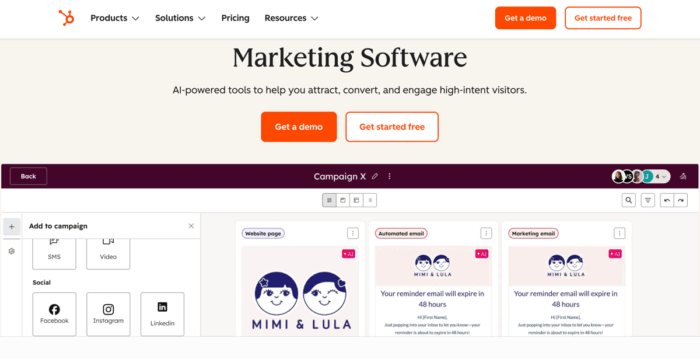Top 7 social media calendar tools
The best social media management tools cover a full spectrum — from content calendar management and deep listening to permissions and analytics. In this guide, we evaluate seven of the top ones based on a number of functions and features.
Top 7 tools for social media management at a glance
Jotform Tables |  Buffer |  Sprout Social |  CoSchedule | Hootsuite |  Zoho Social | HubSpot Marketing Hub | |
|---|---|---|---|---|---|---|---|
| Best for | Account-building and social calendar workflows | Simple scheduling and analytics for small to medium businesses | Enterprise-grade listening and reporting | Calendar-first content and social planning | Robust all-in-one social management | Teams already on Zoho | HubSpot-centric teams needing integrated social and automation |
| Free trial/plan | 30-day trial | 14-day trial |
How to choose the right tool
To find the perfect social media management software for your team, consider and evaluate each platform on these factors:
- Team size
- Channels
- Workflows
- Approval chains and governance
- Listening depth
- Analytics and reporting
- Budget
1. Jotform Tables: Best for account-building and social calendar workflows alongside broader ops
Jotform Tables is a hybrid spreadsheet and database tool that can help your team collect, organize and visualize all kinds of data in ways that go well beyond a simple grid. You can pull in data from Jotform forms, import data in CSV or Excel documents (or add manually), then view and share that data as tables, calendars, cards, or reports. Jotform’s Social Media Calendar template is particularly good if you’re looking to plan posts by channel, content type, date and time.
- How it works: Start with either blank tables or your choice of over 300 ready-made templates, then enter data manually (like a spreadsheet) or through form submissions; sharing and collaboration is built-in, with permission functionality built into the tool
- Pros: Highly flexible tool, with a mix of views making it ideal for different workflows; vast library of robust templates to reduce setup friction; strong collaboration tools
- Cons: Not a fully featured scheduling or publishing tool; performance or loading time might lag with large datasets or complex tables
- Plans/pricing:
- Free plan
- Bronze ($24 per month)
- Silver ($39 per month)
- Additional higher tiers, including an enterprise plan
- G2 rating: 4.6/5
2. Buffer: Best for simple scheduling and analytics for small to medium businesses
Buffer is built to simplify scheduling, publishing, and basic performance tracking across multiple social platforms. It emphasizes ease of use, reliable scheduled posting, and team collaboration — although it’s not terribly robust on social listening and competitive intelligence. If you’re looking for a clean workflow, calendar visibility, and solid analytics, Buffer delivers. If you need more advanced governance or social listening features, you may run up against the tool’s limitations.
- How it works: Connect your social accounts, compose your text and media content, and then schedule either by setting specific times or adding them to a queue or calendar view
- Pros: User-friendly with minimal setup time required; reliable post scheduling across many major social platforms; flexible plans and transparent pricing; clean and intuitive interface
- Cons: Lacks deep social listening features that some more fully featured tools have; analytics and reporting features are more basic at the lower-priced tiers
- Plans/pricing:
- Free
- Essentials ($5 per channel per month, billed annually)
- Team ($10 per channel per month, billed annually)
- G2 rating: 4.3/5
3. Sprout Social: Best for enterprise-grade listening and reporting
Sprout Social is a comprehensive, enterprise-level social media management platform built to handle publishing, engagement, listening, analytics, governance and permissions, and team workflows. It’s great for organizations in search of more than basic scheduling, as Sprout includes tools for social listening, influencer discovery, and reporting. If you’re looking for the right tool for a larger team or you’re an agency in need of advanced permissions and oversight, Sprout Social is a strong contender.
- How it works: Connect your social profiles and then manage publishing tasks through a shared content calendar, queue, drafts, and post previews; the Smart Inbox centralizes messages across your social networks, while listening features track keywords, locations, trends, and user sentiment
- Pros: Deep social listening and monitoring across platforms; workflow tools including Smart Inbox, message tagging, saved asset libraries, and more; detailed analytics
- Cons: Can get expensive, especially for smaller teams; some advanced features are available only on higher-tier plans
- Plans/pricing:
- Standard ($199 per seat per month, billed annually)
- Professional ($299 per seat per month, billed annually)
- Advanced ($399 per seat per month, billed annually)
- Enterprise (custom pricing)
- G2 rating: 4.4/5
4. CoSchedule: Best for calendar-first content and social planning
CoSchedule is a marketing calendar and social media management platform that combines content planning, scheduling and publishing, collaboration, and performance measurement. It aims to give teams a unified calendar view, making it well suited for organizations that want oversight and alignment across content and social. It also offers automation features like recurring content, AI-assisted drafting, and calendar templates to help reduce friction.
- How it works: Set up a shared calendar to create, schedule, preview, and publish social messages; group posts into campaigns, recycle top content, and see analytics and reports in the same interface; team collaboration features include discussions and permissions, especially in higher-tier plans
- Pros: Centralized calendar and content and social scheduling in a single interface; automation features save valuable time; strong collaboration and organizational features
- Cons: Some features are gated behind more expensive plan tiers; can become too expensive for small teams when scaling; moderate learning curve
- Plans/pricing:
- Free
- Social Calendar ($19 per user per month, billed annually)
- Agency Calendar ($59 per user per month, billed annually)
- Content Calendar (custom pricing)
- Marketing Suite (custom pricing, enterprise level)
- G2 rating: 4.4/5
5. Hootsuite: Best for robust all-in-one social management
Hootsuite is a full-featured social media management platform built for teams that need more than scheduling functionality. It can handle publishing, audience engagement, inbox management, social listening, analytics and reporting. It also scales well as organizations grow.
- How it works: Connect your social media accounts to a central dashboard, then use a visual calendar to plan, draft, schedule, and publish content; the inbox aggregates messages and mentions while listening tools track mentions, keywords, sentiment, and more; analytics dashboards provide both high-level metrics and custom reporting, depending on the plan
- Pros: Cross-network support and centralized publishing tools; listening and sentiment tracking, plus good competitor benchmarking; solid workflows and governance features in higher tiers
- Cons: Costs can quickly ramp up with scaling; interface can be increasingly complex with added depth of features
- Plans/pricing:
- Professional ($99 per month, billed annually)
- Team ($249 per month, billed annually)
- Enterprise (custom pricing)
- G2 rating: 4.3/5
6. Zoho Social: Best for teams already on Zoho
Zoho Social is a full-spectrum social media management tool for solo marketers and growing agencies alike. It offers scheduling, multi-channel publishing, social listening, reporting, analytics, and more advanced governance workflows as you move to higher-tier plans. If you manage multiple brands or want robust inbox workflows, Zoho Social may be just what you need.
- How it works: After connecting your brand’s social profiles, you can manage your content from start to finish; schedule posts via a visual calendar, queue your content, use bulk scheduling, recycle evergreen content, preview posts by channel, and engage with messages via a unified inbox
- Pros: Multi-channel scheduling, publishing calendar, message inbox, monitoring, and basic analytics — even in mid-tier plans; scales well; integration-friendly and works well with other Zoho tools; interface is clean and easy to navigate
- Cons: Some forms of support may be gated behind higher-tier plans; analytics and social listening isn’t as deep or flexible as other premium tools
- Plans/pricing:
- Free
- Standard ($10 per month, billed annually)
- Professional ($30 per month, billed annually)
- Premium ($40 per month, billed annually)
- Agency ($230 per month, billed annually)
- Agency Plus ($330 per month, billed annually)
- G2 rating: 4.6/5
7. HubSpot Marketing Hub: Best for HubSpot-centric teams needing integrated social and automation
HubSpot Marketing Hub is a well-rounded inbound marketing automation platform designed to help teams attract, convert, and retain customers with centralized campaigns, content, lead nurturing, and analytics. It helps teams manage diverse formats including email, forms, ads, and social media. Since it’s firmly located within the HubSpot ecosystem, users benefit from tight integration with HubSpot CRM, Sales Hub, and Service Hub. Advanced features are available at higher tiers.
- How it works: Start out by setting up marketing “contacts” and then planning campaigns using email, forms, landing pages, and social media tools; the user interface feels polished and intuitive, with “what you see is what you get” editors, drag-and-drop, and pre-built templates to simplify things; upgrades unlock more advanced tools, including adaptive testing and predictive scoring
- Pros: Sophisticated all-in-one capability — addresses content creation, campaign management, automation, analytics, and customer relationship management (CRM) platform integration; excellent automation tools and deep analytics
- Cons: Pricing can rise quickly when scaling up, particularly for smaller organizations; some users report a moderate learning curve to realize the platform’s full value
- Plans/pricing:
- Free
- Starter ($50 per month, billed annually)
- Professional ($890 per month, billed annually)
- Enterprise ($3,000 per month, billed annually)
- G2 rating: 4.4/5
Social media management and so much more in 2025
With several potential options available to teams of all sizes when it comes to social media management, it’s crucial to first clarify your organization’s specific needs. Then you can look for the platforms with features that align most closely with those needs and goals.
Don’t forget to take full advantage of free trials or plans to confirm a platform’s performance and functionality. Pay attention to its learning curve and user-friendliness, too.
No matter what you’re looking for, there’s a platform out there that can help you simplify and automate your social media workflows.
Looking for smart Instagram automation? Try Jotform Instagram Agent
Jotform Instagram Agent handles direct messages, comments, and story replies automatically, using your account history and brand data to generate human-like responses that maintain your brand voice. It triggers these replies based on follower count, time windows, or user behavior for a smarter approach to engagement.
Unlike simple keyword bots, Jotform Instagram Agent understands context and can seamlessly escalate conversations to actual members of your team when needed. All interactions get captured to your Jotform dashboard and sync with your existing workflows, forms, and CRM systems for unified customer management. The agent is also part of the broader Jotform AI ecosystem, so it can share knowledge across platforms.
Jotform Instagram Agent reliably operates 24-7 through Meta’s official API so you can focus on content creation. Best of all, it’s completely free to use. Give it a try today.
This guide is for social media managers, content leads, comms teams and agency owners who need to pick the right stack for planning, approvals, publishing, listening, and reporting.


















Send Comment:
1 Comments:
More than a year ago
Its cool